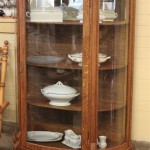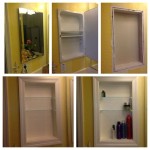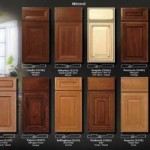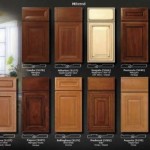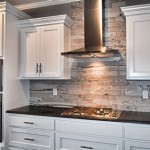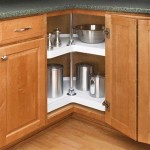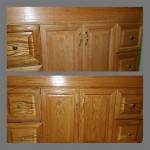Best Way to Remove Cooking Grease From Kitchen Cabinets
Kitchen cabinets, particularly those surrounding cooking areas, are highly susceptible to accumulating cooking grease. This sticky residue, a byproduct of frying, sautéing, and other cooking methods, not only attracts dust and dirt but can also degrade the finish of the cabinets over time. Effective and regular cleaning is essential to maintain the appearance and longevity of kitchen cabinetry. This article explores various methods for removing cooking grease from kitchen cabinets, focusing on safety, efficiency, and the preservation of the cabinet's surface.
The persistent build-up of cooking grease presents a multi-faceted challenge. First, it’s aesthetically unappealing, giving the kitchen a neglected and unhygienic appearance. Second, the sticky surface traps airborne particles, creating a breeding ground for bacteria and mold. This is especially problematic for individuals with allergies or respiratory sensitivities. Third, and perhaps most damaging, is the potential for long-term damage to the cabinet's finish. Grease can seep into the wood or laminate, causing discoloration, warping, and eventual degradation of the material. Thus, proactive cleaning and the selection of appropriate cleaning agents are crucial for maintaining a clean and healthy kitchen environment.
Before initiating any cleaning process, it is critical to identify the type of cabinet material. Kitchen cabinets are typically constructed from wood (solid or veneered), laminate, or metal. Each material requires a specific cleaning approach to avoid damage. Wood cabinets, especially those with a natural finish, are more sensitive to moisture and harsh chemicals than laminate options. Metal cabinets, while more durable, can be susceptible to scratching from abrasive cleaners. Laminate cabinets generally offer the most resilience, but even they can be damaged by excessive heat or harsh solvents. Therefore, always consult the manufacturer's recommendations for cleaning your specific type of cabinet. If the manufacturer's instructions are unavailable, testing the chosen cleaner on an inconspicuous area of the cabinet is advisable before applying it to the entire surface. This ensures the cleaner does not cause discoloration, etching, or other unwanted effects.
Understanding the Composition of Cooking Grease
Cooking grease is not a homogenous substance; it is a complex mixture of fats, oils, and food particles. The composition varies depending on the cooking methods employed and the ingredients used. For example, deep frying in vegetable oil produces a different type of grease residue than sautéing with butter. High temperatures cause these fats and oils to polymerize, creating a sticky, resistant film. This film is further compounded by the accumulation of airborne dust, flour, and other kitchen debris, resulting in a stubborn layer that is difficult to remove with simple wiping. Understanding this composition is essential for selecting the appropriate cleaning agent. Solvents that can dissolve fats and oils are necessary, but they must also be safe for the cabinet material and gentle enough not to damage the finish. Moreover, the emulsifying properties of certain cleaners help lift the grease away from the surface, preventing it from simply being smeared around.
The age and thickness of the grease buildup also play a significant role in the cleaning process. Fresh grease splatters are generally easier to remove than layers that have been allowed to accumulate over time. Aged grease tends to harden and bond more tightly to the cabinet surface, requiring more aggressive cleaning methods. In such cases, pre-treating the affected area with a degreasing solution or applying heat to soften the residue can significantly improve the cleaning outcome. Regular cleaning routines are essential to prevent the accumulation of thick layers of grease and to minimize the need for harsh cleaning agents.
Effective Cleaning Solutions for Removing Cooking Grease
Several cleaning solutions are effective for removing cooking grease from kitchen cabinets, ranging from readily available household items to specialized cleaning products. The choice of solution should be based on the severity of the grease buildup, the type of cabinet material, and the user's preference for natural versus chemical cleaners.
One of the most widely used and effective natural cleaning solutions is a mixture of warm water and dish soap. Dish soap contains surfactants that help to break down grease and lift it away from the surface. The mixture should be prepared with warm water, as heat helps to dissolve the grease more effectively. Apply the solution to the cabinets using a soft cloth or sponge, gently scrubbing the affected areas. Avoid using abrasive scrubbers, as they can scratch the cabinet finish. After scrubbing, rinse the cabinets with clean water and dry them thoroughly with a clean cloth. This method is generally safe for most cabinet materials, but testing in an inconspicuous area is still recommended.
Another popular natural cleaning agent is vinegar. Vinegar is a mild acid that can effectively cut through grease and grime. To use vinegar, mix equal parts of white vinegar and warm water in a spray bottle. Spray the solution onto the cabinets and let it sit for a few minutes to allow the vinegar to penetrate the grease. Then, wipe the cabinets clean with a soft cloth or sponge. Be sure to rinse the cabinets with clean water and dry them thoroughly. While vinegar is generally safe for most cabinet materials, it can be too acidic for certain finishes, so testing is essential. The distinct smell of vinegar may be off-putting to some, but it dissipates quickly.
Baking soda is a mild abrasive that can be used to remove stubborn grease stains. To use baking soda, make a paste by mixing it with a small amount of water. Apply the paste to the affected area and gently scrub with a soft cloth or sponge. Rinse the cabinets with clean water and dry them thoroughly. Baking soda can be effective for removing grease from tougher cabinet surfaces, such as laminate. However, it should be used with caution on wood cabinets, as it can scratch the finish. Testing in an inconspicuous area is particularly important when using baking soda.
For more heavily soiled cabinets, commercial degreasers may be necessary. These products are specifically formulated to break down grease and grime, and they often contain stronger solvents than household cleaners. When using commercial degreasers, it is crucial to follow the manufacturer's instructions carefully. Wear gloves and eye protection to avoid irritation, and ensure adequate ventilation in the kitchen. Apply the degreaser to the cabinets using a soft cloth or sponge, and allow it to sit for the recommended amount of time. Rinse the cabinets thoroughly with clean water and dry them with a clean cloth. Avoid using commercial degreasers on delicate cabinet finishes, and always test in an inconspicuous area first.
Step-by-Step Cleaning Process and Preventive Measures
A systematic approach to cleaning kitchen cabinets ensures thorough grease removal while minimizing the risk of damage. The process should begin with preparation, followed by cleaning, rinsing, and drying. Implementing preventive measures after cleaning helps to reduce future grease buildup.
The initial step involves preparing the area. Remove any items from the countertops below the cabinets to prevent them from getting wet or soiled. Cover the countertops with towels or plastic sheeting to protect them from drips. Gather all necessary cleaning supplies, including the chosen cleaning solution, soft cloths, sponges, a bucket of warm water, and a dry towel. Wearing gloves is recommended to protect the skin from exposure to cleaning solutions.
Next, pre-treat any areas with heavy grease buildup. Apply a generous amount of the chosen cleaning solution to the affected areas and allow it to sit for several minutes. This will help to loosen the grease and make it easier to remove. For stubborn stains, consider using a paste of baking soda and water or a commercial degreaser specifically designed for grease removal.
Once the pre-treatment is complete, begin cleaning the cabinets. Dip a soft cloth or sponge into the warm water and cleaning solution, and gently scrub the cabinets in a circular motion. Avoid using excessive pressure, as this can damage the finish. Pay particular attention to areas around the stovetop and sink, as these are typically the most heavily soiled. If necessary, use a small brush or cotton swab to clean crevices and tight spaces.
After cleaning, rinse the cabinets thoroughly with clean water. Use a clean, damp cloth to wipe away any remaining cleaning solution. It is crucial to remove all traces of the cleaner to prevent residue buildup, which can attract dust and dirt. Ensure that the cloth is wrung out well to avoid excessive moisture on the cabinets, especially wood cabinets.
Finally, dry the cabinets thoroughly with a clean, dry cloth. This will help to prevent water spots and streaks. Pay particular attention to seams and edges, as these areas are prone to trapping moisture, which can lead to mold and mildew growth. A microfiber cloth is ideal for drying, as it is absorbent and leaves a streak-free finish.
Preventive measures are essential for minimizing future grease buildup. Regularly wiping down the cabinets with a damp cloth after cooking helps to remove fresh splatters before they harden. Using a range hood or exhaust fan while cooking helps to vent grease and steam away from the cabinets. Consider applying a protective coating, such as wax or a sealant, to the cabinets to create a barrier against grease and moisture. Avoid placing cooking appliances, such as toasters and blenders, directly under the cabinets, as they can contribute to grease buildup. By implementing these preventive measures, the frequency and intensity of cabinet cleaning can be significantly reduced, preserving the appearance and longevity of the kitchen.

How To Clean Sticky Grease Off Kitchen Cabinets Ovenclean
:max_bytes(150000):strip_icc()/ways-to-clean-wood-kitchen-cabinets-3017289-01-765f893e7cca49a1ab72d7c49efdf518.jpg?strip=all)
Tips For Cleaning Food Grease From Wood Cabinets

How To Clean Grimy Kitchen Cabinets With 2 Ingredients

3 Super Easy Ways To Clean White Kitchen Cabinets And Avoid

How To Clean Sticky Grease Off Kitchen Cabinets

How To Remove Oven Grease From Kitchen Cabinets American Appliance Inc

How To Clean Cooking Grease And Oil Bond Cleaning In Sydney

How To Clean Grease Off The Most Common Kitchen Surfaces
5 Great Ways To Clean Grease Howstuffworks

How To Clean White Kitchen Cabinets 3 Best Ways Avoid Abbotts At Home
Related Posts

